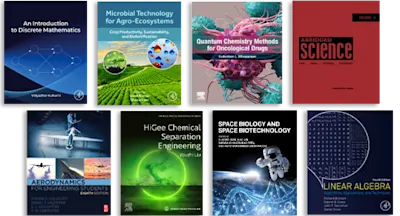
Modern Ion Plating Technology
Fundamentals and Applications
- 1st Edition - September 29, 2022
- Latest edition
- Authors: Fuzhen Wang, Junwei Wu
- Language: English
Modern Ion Plating Technology: Fundamentals and Applications discusses the fundamental concepts of plasma physics in various coating technologies and explores its develo… Read more

- Presents both the principle and processes of various ion plating technology
- Introduces the fundamental physics of ion plating
- Includes the application of ion plating technology in high-tech products
Students. Chemists
1. Introduction of Ion Plating Technology
1.1 New Requirements for High-tech Products
1.2 Definition of Ion Plating Technology
1.3 Characteristics of Ion Plating Technology
1.4 Classification of Ion Plating Technology
2. Fundamental of Vacuum Physics
2.1 Definition of Vacuum
2.2 Vacuum Level and Classifications
2.3 Basic Law of Gas kinetics
2.4 Gas Molecule and Surface Action
2.5 Electron Emission from Cathode Surface
3. Fundamental of Plasma Physics
3.1 Overview of Plasma
3.2 Definition of plasma
3.3 Acquisition of Vacuum Plasma
3.4 Classification of Plasmas
3.5 Low Pressure Gas Discharge
3.5.1 Motion of Charged Particles in Gas
3.5.2 Law of Collision between Particles
3.5.3 Ionization and Excitation of Gas
3.5.4 Elimination of Charged Particles
3.5.5 Plasma chemistry
3.6 3.6 Development Process of Gas Discharge
3.6.1 Development Process of Gas Discharge
3.6.2 Equivalent Anode
3.6.3 Ignition Conditions of Gas Discharge
3.7 Volt-Ampere Properties of Gas Discharge
3.8 Glow Discharge
3.8.1 Characteristics of Glow Discharge
3.8.2 Cathode potential drop
3.8.3 Normal and Abnormal Glow Discharges
3.8.4 Characteristic zone of glow discharge electrodes
3.8.5 Hollow cathode effect
3.8.6 High Frequency Glow Discharge
3.9 Arc discharge
3.9.1 Characteristics of Arc discharge
3.9.2 Classification of Arc Discharge
3.9.3 Volt Ampere Properties of Arc Discharge
3.9.4 Hot Electron Arc Discharge
3.9.5 Cold Self-sustaining Arc Discharge
3.10 Interaction of Charged Particles and Electrodes
3.10.1 Interaction of Ion and Cathode
3.10.2 Interaction of Electrons with Anode
3.11 Motion of Charged Particles in Electromagnetic Field
3.11.1 Motion of Charged Particles in Electric Field
3.11.2 Motion of Charged Particles in Magnetic Field
3.11.3 Motion of Charged Particles in Electromagnetic Field
3.11.4 Application of Electromagnetic Field in Coating systems
4. Classification of Vacuum Plating Technology
4.1 Introduction of Vacuum Plating Technology
4.2 Significance of Vacuum Plating Technology
4.3 Classification of Vacuum Plating
4.4 Characteristics of Physical Vapor Deposition
4.5 Characteristics of Chemical Vapor Deposition
5. Vacuum Evaporation Plating
5.1 Physical Significance for Vacuum Evaporation
5.2 Classification of Evaporation Plating
5.3 Vacuum Evaporation systems
5.4 Microstructure of Evaporative Coatings
6. Glow discharge Ion plating
6.1 Overview of Glow Discharge Ion Plating
6.2 Principle of Dipolar Glow Discharge Ion Plating
6.3 Dipolar Glow Discharge Ion Plating Process
6.4 Microstructure of Dipolar Glow Discharge Ion Plating
6.5 Characteristics of Dipolar Glow Discharge Ion Plating
6.6 Development of Glow Discharge Ion Plating
7. Hot Arc Ion Plating
7.1 Principle of Hollow Cathode Ion Plating
7.1.1 Introduction of Hollow Cathode Ion Plating
7.1.2 Technical Process of Hollow Cathode Ion Plating
7.1.3 Microstructure of Hollow Cathode coatings
7.1.4 Technical characteristics of hollow cathode ion plating
7.1.5 Electromagnetic Field in Hollow Cathode Ion Plating
7.2 Hot Wire Arc Ion Plating
7.2.1 Introduction of Hot Wire Arc Ion Plating
7.2.2 Technical Process of Hot Wire Arc Ion Plating
7.2.3 Electromagnetic Field in Hot Wire Arc Ion Plating
8. Cathodic Arc Ion Plating
8.1 Cathodic Arc Devices
8.2 Technical Process of Arc Ion Plating
8.3 Mechanism of Arc Ion Plating
8.4 Measures to filter macroparticles from Arc Ion plating
8.5 Shapes of Cathodic Arc Sources
8.6 Microstructure Characteristics of Arc Ion Plating
8.7 Technical Characteristics of Arc Ion Plating
8.8 Pulse Bias in Arc Ion Plating
8.9 Progress of Arc Ion Plating
9. Magnetron Sputtering Technology
9.1 Principle of Sputtering
9.2 Technical Process of Sputtering
9.3 Magnetron Sputtering Technology
9.4 Shapes of Magnetron Sputtering Targets
9.5 Microstructure of Magnetron Sputtered coatings
9.6 Progress of Magnetron Sputtering Technology
9.6.1 Balanced and Unbalanced Magnetron Sputtering
9.6.2 Unbalanced Closed Magnetic Field
9.6.3 Mid-Frequency Power Supply and Twin Targets
9.6.4 High Power Impulse Magnetron Sputtering Technology
10. Plasma chemical vapor deposition (CVD)
10.1 Introduction of CVD
10.1.1 Thermal CVD
10.1.2 Metal organic chemical vapor deposition (MOCVD)
10.1.3 Atomic Layer Deposition
10.2 Plasma Assisted Chemical Vapor Deposition (PACVD)
10.2.1 Principle of PACVD
10.2.2 Glow Discharge PACVD
10.2.3 Roll to roll PACVD
10.2.4 Arc discharged PACVD
11. Function of Charged Particle Beams in Plating
11.1 Function of Ion Beam
11.1.1 Energy of Ion Beam
11.1.2 Ion Beam Assisted Deposition
11.2 Function of Arc electric Current
11.2.1 Applications of Arc electric current for ionization
11.2.2 Arc Electric Current Assisted Deposition
11.2.3 Hot Electron Enhanced Ion Nitriding Technology
12. Application of Ion Plating
12.1 Hard Coatings
12.1.1 Requirements for Coated Tools in High-end Processing Industry
12.1.2 Types of Hard Coated Tools
12.1.3 New Application of Hard Coating
12.1.4 New Requirements for Hard Coatings
12.1.5 Development of Hard Coating for wear Resistant Parts
12.2 Protective coatings
12.2.1 Anticorrosive Coating
12.2.2 Thermal Barrier Coating
12.3 Optical coatings
12.3.1 Antireflective coating
12.3.2 Reflectance coating
12.3.3 Electrochromic Glass
12.3.4 Hydrophobic and hydrophilic coating
12.3.5 Other optical coatings
12.4 Coatings in Solar Energy
12.4.1 Photothermal Conversion coating
12.4.2 Photoelectric Conversion coating
12.5 Integrated Circuit production
12.5.1 Integrated Circuit
12.5.2 Discrete Device Processing
12.6 Information Display Devices
12.6.1 Flat Panel Display Devices
12.6.2 Flexible Microelectronic Devices
12.6.3 Information Memory Devices
12.7 Decorative Products
12.7.1 Watches related Metallic Decorations
12.7.2 Plastic Decorations
12.8 New Applications on Flexible Substrates
12.8.1 Capacitors
12.8.2 High barrier coatings
12.8.3 Shielding coatings
12.8.4 Nickel coatings for Ni-MH Batteries
12.8.5 Flexible Solar Cell coatings
12.8.6 Flexible Microelectronic Devices
12.8.7 Flexible foldable Large Screen Display
- Edition: 1
- Latest edition
- Published: September 29, 2022
- Language: English
FW
Fuzhen Wang
JW